Chen Cai
Towards Blind Bitstream-corrupted Video Recovery via a Visual Foundation Model-driven Framework
Jul 30, 2025Abstract:Video signals are vulnerable in multimedia communication and storage systems, as even slight bitstream-domain corruption can lead to significant pixel-domain degradation. To recover faithful spatio-temporal content from corrupted inputs, bitstream-corrupted video recovery has recently emerged as a challenging and understudied task. However, existing methods require time-consuming and labor-intensive annotation of corrupted regions for each corrupted video frame, resulting in a large workload in practice. In addition, high-quality recovery remains difficult as part of the local residual information in corrupted frames may mislead feature completion and successive content recovery. In this paper, we propose the first blind bitstream-corrupted video recovery framework that integrates visual foundation models with a recovery model, which is adapted to different types of corruption and bitstream-level prompts. Within the framework, the proposed Detect Any Corruption (DAC) model leverages the rich priors of the visual foundation model while incorporating bitstream and corruption knowledge to enhance corruption localization and blind recovery. Additionally, we introduce a novel Corruption-aware Feature Completion (CFC) module, which adaptively processes residual contributions based on high-level corruption understanding. With VFM-guided hierarchical feature augmentation and high-level coordination in a mixture-of-residual-experts (MoRE) structure, our method suppresses artifacts and enhances informative residuals. Comprehensive evaluations show that the proposed method achieves outstanding performance in bitstream-corrupted video recovery without requiring a manually labeled mask sequence. The demonstrated effectiveness will help to realize improved user experience, wider application scenarios, and more reliable multimedia communication and storage systems.
CL-HOI: Cross-Level Human-Object Interaction Distillation from Vision Large Language Models
Oct 21, 2024Abstract:Human-object interaction (HOI) detection has seen advancements with Vision Language Models (VLMs), but these methods often depend on extensive manual annotations. Vision Large Language Models (VLLMs) can inherently recognize and reason about interactions at the image level but are computationally heavy and not designed for instance-level HOI detection. To overcome these limitations, we propose a Cross-Level HOI distillation (CL-HOI) framework, which distills instance-level HOIs from VLLMs image-level understanding without the need for manual annotations. Our approach involves two stages: context distillation, where a Visual Linguistic Translator (VLT) converts visual information into linguistic form, and interaction distillation, where an Interaction Cognition Network (ICN) reasons about spatial, visual, and context relations. We design contrastive distillation losses to transfer image-level context and interaction knowledge from the teacher to the student model, enabling instance-level HOI detection. Evaluations on HICO-DET and V-COCO datasets demonstrate that our CL-HOI surpasses existing weakly supervised methods and VLLM supervised methods, showing its efficacy in detecting HOIs without manual labels.
Empowering Large Language Model for Continual Video Question Answering with Collaborative Prompting
Oct 01, 2024



Abstract:In recent years, the rapid increase in online video content has underscored the limitations of static Video Question Answering (VideoQA) models trained on fixed datasets, as they struggle to adapt to new questions or tasks posed by newly available content. In this paper, we explore the novel challenge of VideoQA within a continual learning framework, and empirically identify a critical issue: fine-tuning a large language model (LLM) for a sequence of tasks often results in catastrophic forgetting. To address this, we propose Collaborative Prompting (ColPro), which integrates specific question constraint prompting, knowledge acquisition prompting, and visual temporal awareness prompting. These prompts aim to capture textual question context, visual content, and video temporal dynamics in VideoQA, a perspective underexplored in prior research. Experimental results on the NExT-QA and DramaQA datasets show that ColPro achieves superior performance compared to existing approaches, achieving 55.14\% accuracy on NExT-QA and 71.24\% accuracy on DramaQA, highlighting its practical relevance and effectiveness.
CM2-Net: Continual Cross-Modal Mapping Network for Driver Action Recognition
Jun 18, 2024Abstract:Driver action recognition has significantly advanced in enhancing driver-vehicle interactions and ensuring driving safety by integrating multiple modalities, such as infrared and depth. Nevertheless, compared to RGB modality only, it is always laborious and costly to collect extensive data for all types of non-RGB modalities in car cabin environments. Therefore, previous works have suggested independently learning each non-RGB modality by fine-tuning a model pre-trained on RGB videos, but these methods are less effective in extracting informative features when faced with newly-incoming modalities due to large domain gaps. In contrast, we propose a Continual Cross-Modal Mapping Network (CM2-Net) to continually learn each newly-incoming modality with instructive prompts from the previously-learned modalities. Specifically, we have developed Accumulative Cross-modal Mapping Prompting (ACMP), to map the discriminative and informative features learned from previous modalities into the feature space of newly-incoming modalities. Then, when faced with newly-incoming modalities, these mapped features are able to provide effective prompts for which features should be extracted and prioritized. These prompts are accumulating throughout the continual learning process, thereby boosting further recognition performances. Extensive experiments conducted on the Drive&Act dataset demonstrate the performance superiority of CM2-Net on both uni- and multi-modal driver action recognition.
Local-to-global Perspectives on Graph Neural Networks
Jun 18, 2023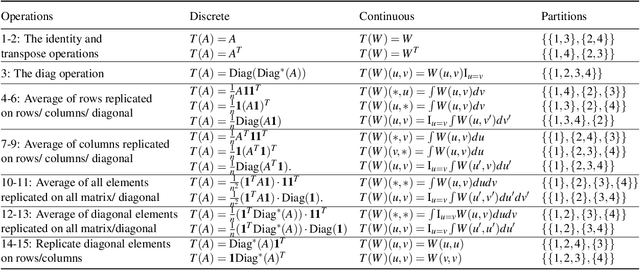


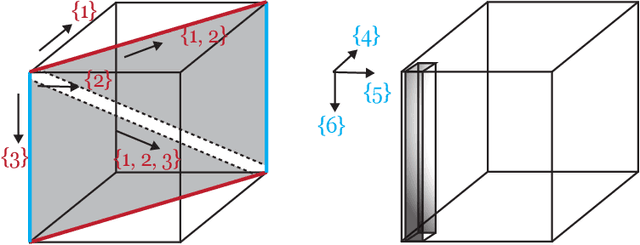
Abstract:This thesis presents a local-to-global perspective on graph neural networks (GNN), the leading architecture to process graph-structured data. After categorizing GNN into local Message Passing Neural Networks (MPNN) and global Graph transformers, we present three pieces of work: 1) study the convergence property of a type of global GNN, Invariant Graph Networks, 2) connect the local MPNN and global Graph Transformer, and 3) use local MPNN for graph coarsening, a standard subroutine used in global modeling.
Top-Down Viewing for Weakly Supervised Grounded Image Captioning
Jun 15, 2023Abstract:Weakly supervised grounded image captioning (WSGIC) aims to generate the caption and ground (localize) predicted object words in the input image without using bounding box supervision. Recent two-stage solutions mostly apply a bottom-up pipeline: (1) first apply an off-the-shelf object detector to encode the input image into multiple region features; (2) and then leverage a soft-attention mechanism for captioning and grounding. However, object detectors are mainly designed to extract object semantics (i.e., the object category). Besides, they break down the structural images into pieces of individual proposals. As a result, the subsequent grounded captioner is often overfitted to find the correct object words, while overlooking the relation between objects (e.g., what is the person doing?), and selecting incompatible proposal regions for grounding. To address these difficulties, we propose a one-stage weakly supervised grounded captioner that directly takes the RGB image as input to perform captioning and grounding at the top-down image level. In addition, we explicitly inject a relation module into our one-stage framework to encourage the relation understanding through multi-label classification. The relation semantics aid the prediction of relation words in the caption. We observe that the relation words not only assist the grounded captioner in generating a more accurate caption but also improve the grounding performance. We validate the effectiveness of our proposed method on two challenging datasets (Flick30k Entities captioning and MSCOCO captioning). The experimental results demonstrate that our method achieves state-of-the-art grounding performance.
On the Connection Between MPNN and Graph Transformer
Feb 03, 2023Abstract:Graph Transformer (GT) recently has emerged as a new paradigm of graph learning algorithms, outperforming the previously popular Message Passing Neural Network (MPNN) on multiple benchmarks. Previous work (Kim et al., 2022) shows that with proper position embedding, GT can approximate MPNN arbitrarily well, implying that GT is at least as powerful as MPNN. In this paper, we study the inverse connection and show that MPNN with virtual node (VN), a commonly used heuristic with little theoretical understanding, is powerful enough to arbitrarily approximate the self-attention layer of GT. In particular, we first show that if we consider one type of linear transformer, the so-called Performer/Linear Transformer (Choromanski et al., 2020; Katharopoulos et al., 2020), then MPNN + VN with only O(1) depth and O(1) width can approximate a self-attention layer in Performer/Linear Transformer. Next, via a connection between MPNN + VN and DeepSets, we prove the MPNN + VN with O(n^d) width and O(1) depth can approximate the self-attention layer arbitrarily well, where d is the input feature dimension. Lastly, under some assumptions, we provide an explicit construction of MPNN + VN with O(1) width and O(n) depth approximating the self-attention layer in GT arbitrarily well. On the empirical side, we demonstrate that 1) MPNN + VN is a surprisingly strong baseline, outperforming GT on the recently proposed Long Range Graph Benchmark (LRGB) dataset, 2) our MPNN + VN improves over early implementation on a wide range of OGB datasets and 3) MPNN + VN outperforms Linear Transformer and MPNN on the climate modeling task.
Traffic4cast at NeurIPS 2021 -- Temporal and Spatial Few-Shot Transfer Learning in Gridded Geo-Spatial Processes
Apr 01, 2022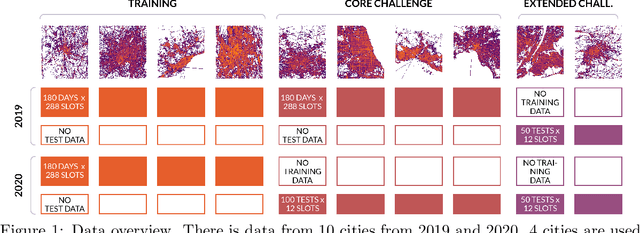
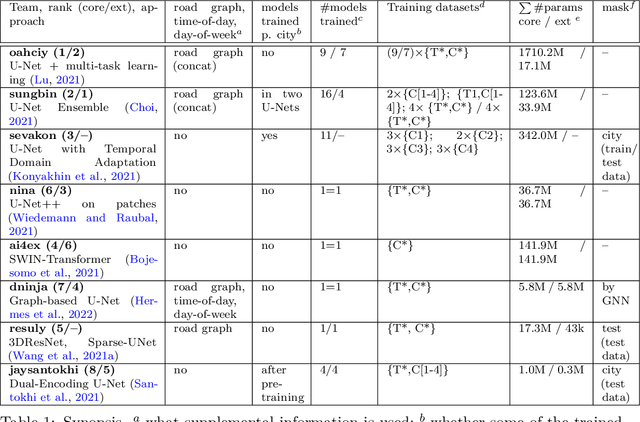


Abstract:The IARAI Traffic4cast competitions at NeurIPS 2019 and 2020 showed that neural networks can successfully predict future traffic conditions 1 hour into the future on simply aggregated GPS probe data in time and space bins. We thus reinterpreted the challenge of forecasting traffic conditions as a movie completion task. U-Nets proved to be the winning architecture, demonstrating an ability to extract relevant features in this complex real-world geo-spatial process. Building on the previous competitions, Traffic4cast 2021 now focuses on the question of model robustness and generalizability across time and space. Moving from one city to an entirely different city, or moving from pre-COVID times to times after COVID hit the world thus introduces a clear domain shift. We thus, for the first time, release data featuring such domain shifts. The competition now covers ten cities over 2 years, providing data compiled from over 10^12 GPS probe data. Winning solutions captured traffic dynamics sufficiently well to even cope with these complex domain shifts. Surprisingly, this seemed to require only the previous 1h traffic dynamic history and static road graph as input.
Generative Coarse-Graining of Molecular Conformations
Jan 28, 2022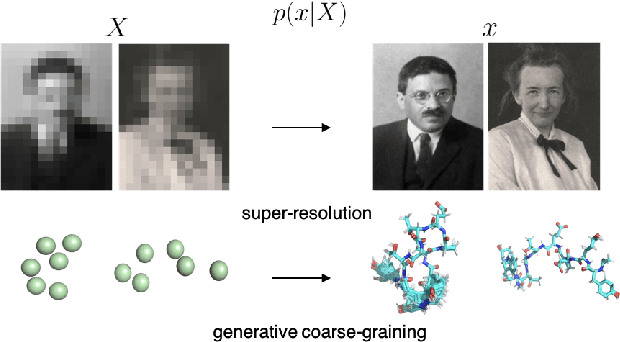

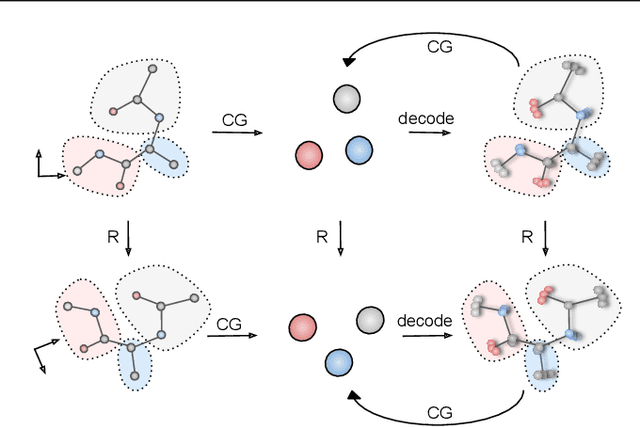

Abstract:Coarse-graining (CG) of molecular simulations simplifies the particle representation by grouping selected atoms into pseudo-beads and therefore drastically accelerates simulation. However, such CG procedure induces information losses, which makes accurate backmapping, i.e., restoring fine-grained (FG) coordinates from CG coordinates, a long-standing challenge. Inspired by the recent progress in generative models and equivariant networks, we propose a novel model that rigorously embeds the vital probabilistic nature and geometric consistency requirements of the backmapping transformation. Our model encodes the FG uncertainties into an invariant latent space and decodes them back to FG geometries via equivariant convolutions. To standardize the evaluation of this domain, we further provide three comprehensive benchmarks based on molecular dynamics trajectories. Extensive experiments show that our approach always recovers more realistic structures and outperforms existing data-driven methods with a significant margin.
Convergence of Invariant Graph Networks
Jan 25, 2022



Abstract:Although theoretical properties such as expressive power and over-smoothing of graph neural networks (GNN) have been extensively studied recently, its convergence property is a relatively new direction. In this paper, we investigate the convergence of one powerful GNN, Invariant Graph Network (IGN) over graphs sampled from graphons. We first prove the stability of linear layers for general $k$-IGN (of order $k$) based on a novel interpretation of linear equivariant layers. Building upon this result, we prove the convergence of $k$-IGN under the model of \citet{ruiz2020graphon}, where we access the edge weight but the convergence error is measured for graphon inputs. Under the more natural (and more challenging) setting of \citet{keriven2020convergence} where one can only access 0-1 adjacency matrix sampled according to edge probability, we first show a negative result that the convergence of any IGN is not possible. We then obtain the convergence of a subset of IGNs, denoted as IGN-small, after the edge probability estimation. We show that IGN-small still contains function class rich enough that can approximate spectral GNNs arbitrarily well. Lastly, we perform experiments on various graphon models to verify our statements.
 Add to Chrome
Add to Chrome Add to Firefox
Add to Firefox Add to Edge
Add to Edge